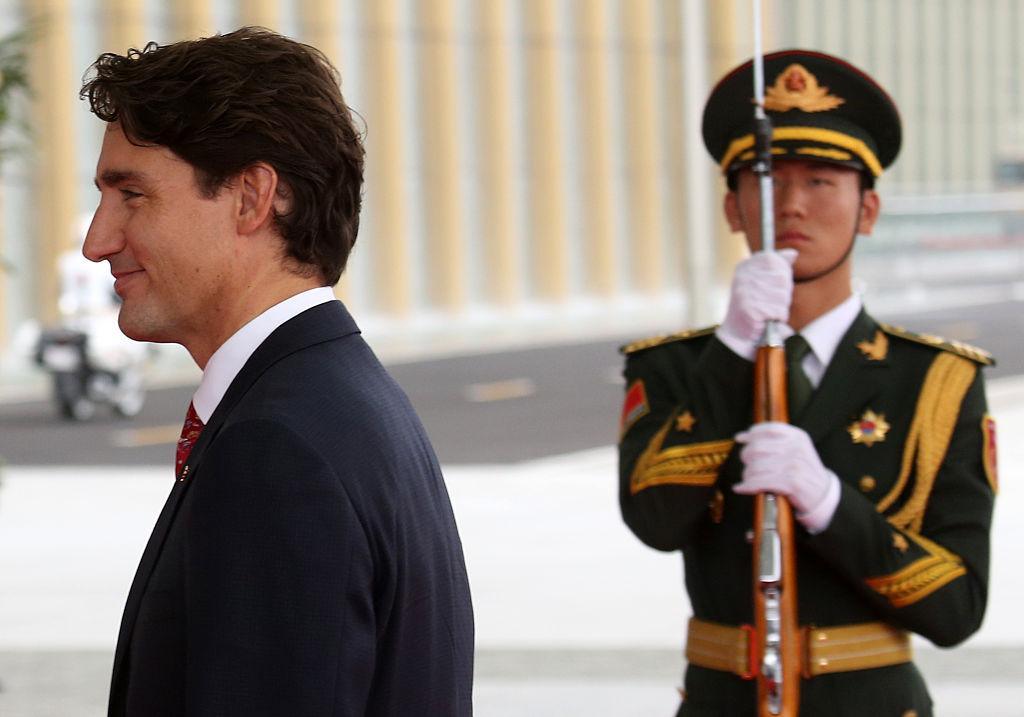
Amid Canada’s public inquiry into foreign interference, the Chinese Communist Party is deploying inauthentic personas on social media and extending its influence operations into the Canadian online environment.
ASPI has identified a cross-platform, coordinated network of inauthentic social media accounts spreading disinformation about Canadian politicians, mostly targeting Prime Minister Justin Trudeau. These accounts claim that Canadian politicians are corrupt, philanderers or liars and have used deepfake technology to falsely attribute these allegations to Liu Xin, a political ‘vlogger’ (video blogger) of Chinese heritage based in Canada. Some family members and associates of Canadian politicians are also being targeted through this new campaign.
ASPI assesses that this network is highly likely a new iteration of the Spamouflage network, which has been linked to Chinese government-affiliated entities numerous times. If that’s correct, it would be the first publicly unearthed example of the CCP using an AI-enabled face swap in its internationally focused information operations and disinformation campaigns.
As part of the new campaign, a subnetwork of accounts is promoting an article published by Red Maple News, an influential Chinese-Canadian online media outlet. The article launders personal—and publicly unavailable—information to defame Teacher Li, a pseudonym for a Chinese painter based in Italy.
Beginning on 7 August, around 2,000 inauthentic social media accounts published more than 15,000 posts in English, French and Mandarin on X (formerly Twitter), Facebook and YouTube targeting at least 50 Canadian politicians from both major political parties, the Liberal Party of Canada and the Conservative Party of Canada. The campaign appears to have subsided since 11 September, four days after the Canadian government’s announcement of a public inquiry into foreign interference. At the time of writing, the network continues to target Liu.
The most common modus operandi of these accounts is to flood replies under both the official and personal social media accounts of Canadian politicians. On X, sometimes the only replies to a politician’s tweet are from inauthentic accounts in the network. The majority of these tweet replies contain disinformation. A strategy of this information operation is to try to draw online users’ attention to claims that, for example, Canadian politicians are corrupt, racist or having extramarital affairs.
The families and associates of Canadian politicians have also been dragged into this activity. This includes posts alleging that the politicians were neglecting their family members, that they fathered illegitimate children or that their children’s sexual orientation was uncertain. Often the phrases used in these posts indicate that the accounts’ operators are most likely non-native English speakers or have used automatic translation services. For example, one post claimed that a politician was engaging in ‘sex transactions’.
In another case, accounts targeting Steven Guilbeault, Canada’s environment and climate change minister, blended an old photo of him being arrested with a sentence outlining his pro-environmental positions and claiming that he reviews the ‘pornhub [a pornography website] web browsing history of every taxpayer in Canada’.
Figure 1: Screenshots of Spamouflage accounts targeting Canadian politicians

Trudeau appears to be the primary target of this operation and is mentioned in at least 4,152 posts (around 25% of all posts). Under Trudeau’s social media posts, accounts in this network spread claims that he is a ‘liar’, a ‘rapist’ and is ‘embezzling’ public funds. On X, accounts also post links to YouTube videos about Trudeau uploaded by other inauthentic YouTube accounts associated with this network. One of these YouTube videos, which attracted over 100 views, shows Liu saying that Trudeau ‘loves pornography’ and repeating a known conspiracy theory that Trudeau paid a ‘wealthy businessman’ to cover up sexual relations with an underage girl.
ASPI assesses that this video is likely the first publicly unearthed example of a sophisticated deepfake audio and face swap commissioned by this network, commonly known as Spamouflage by the research community. The video attempts to use Liu’s face and voice to spread disinformation about Trudeau. It features a common backdrop that Liu uses, but the audio and video slightly differ slightly from Liu’s usual videos. At around 23 and 28 seconds in, the chin of the potentially AI-imposed face is misaligned with the underlying face. Other considerations, such as the fake face lacking the facial expressions, skin blemishes and wrinkles of Liu’s actual face when he speaks in his videos, further suggest that this video has been manipulated. The audio and editing are of poor quality and the video glitches at the 26-second timestamp. Liu has also never uploaded a similar video about Trudeau to his YouTube channel.
Figure 2: Screenshots of deepfake video on the left and in the middle, with screenshots of Liu Xin’s real face and video on the right as a comparison

ASPI assesses that this new coordinated network of inauthentic accounts targeting Canadian politicians and their families, as well as Liu, are very likely linked to the Chinese government. For example, accounts tend to post between Beijing’s 9 am to 9 pm business hours, a common tell of the Spamouflage network. The accounts’ timelines also reveal that some of them were involved in previous CCP influence operations. As an example, one account named Esther Walter that is targeting Justin Trudeau and Liu has previously posted disinformation about Japan’s Fukushima treated wastewater discharge and replied to accounts using the #weatherweapon hashtag, which has been used in connection with a conspiracy story that the Hawaiian wildfires were engineered by the US military. Both of these narratives have previously been co-opted by CCP-linked influence operations on social media, according to ASPI and NewsGuard research. According to ASPI research, a US Department of Justice unsealed complaint and Meta’s latest quarterly report, there’s evidence that this network is partly associated with China’s Ministry of Public Security.
Like with many CCP information operations, most posts in this latest campaign have had zero or minimal engagement with real users. The post with the most engagements appears to have only interacted with other inauthentic accounts in the network and failed to break out of this community. However, it’s difficult to measure the specific impact of such operations given that their intent remains ambiguous. In this case, the CCP is likely aiming to harass and intimidate, rather than attract major engagement. This type of digital transnational repression has become a growing focus for the CCP and continues to be used; for example, bespoke harassment and disinformation campaigns have targeted Asian women based in the US, UK and Australia working in journalism, human rights activism and think tanks. In the case of Liu, and in addition to attempts to intimidate and silence him, the new campaign might also be trying to shape Canadian politicians’ perceptions of him, as well as seeking to undermine his work and public reputation.
It’s important to note that while Liu is the target of this campaign, he has spread unverified claims on his X and YouTube channels as well. On 8 October, Liu uploaded a Mandarin-language video on his ‘Lao Deng’ (老灯) YouTube channel and, a day later, an English-language tweet that spread unverified claims of the CCP assassinating the Canadian Sikh leader Hardeep Singh Nijjar to frame India and create discord between India and the West. This story has been disseminated by Indian media outlets, without context or critical examination of the source.
In the second part of this investigation, to be published later today, we show how Spamouflage accounts bolster CCP united front work in Canada. This provides evidence of CCP online and offline influence operations being coordinated and mutually reinforcing.
Update: Global Affairs Canada has released a statement about this activity that cites ASPI’s work and makes the same attribution.

